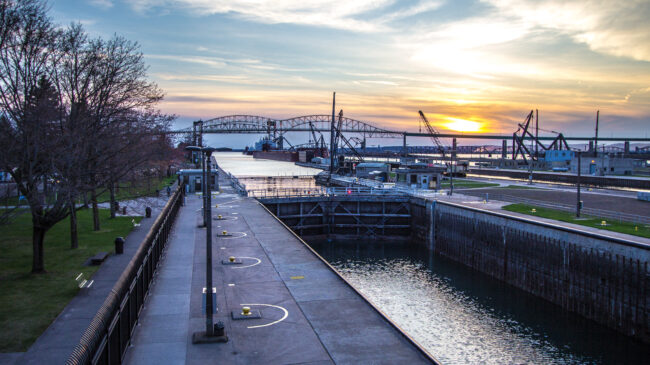At first glance, the inland waterways system in the United States appears to be a cost-effective, environmentally-friendly method of moving freight. But the waterways are artificially inexpensive for their users partly because taxpayers cover the lion’s share of the costs. The current state of waterway funding makes the system financially unstable and costs taxpayers hundreds of millions of dollars each year. Some of the core problems plaguing this system, such as the lack of robust funding and the inability to handle an ever-growing maintenance backlog, are contributing to the trend of decreasing commercial activity in our inland waterways.
The decline of the inland waterways system has other economic and environmental impacts. Problems with waterways are shifting freight to trucks, which is worsening traffic congestion on roads and highways and increasing greenhouse gas emissions.
The Inland Waterways User Board (IWUB) consists of 11 members representing all geographic areas on the inland waterways system and is tasked with developing the United States Army Corps of Engineers (USACE) budget proposal, including the prioritization and selection of projects, as well as monitoring the Inland Waterways Trust Fund (IWTF).
Under the status quo, capital projects and operations and maintenance (O&M) are funded differently. For capital projects, the costs are split 65/35 between the Inland Waterways Trust Fund and general fund taxpayer revenues until fiscal year 2031, up from a 50/50 split that existed since 1986. However, the Water Resources Development Act of 2022 (WRDA) proposed lowering the IWTF share to 25% permanently. For operations and maintenance, general fund expenditures cover 100%.
The biggest problem with how waterways are funded stems from the large subsidies from federal taxpayers to the waterway system. Taxpayers reap none of the direct benefits of the inland waterway system. By changing the IWTF’s funding structure to a lock-usage fee in which all users of the waterway system would pay and removing all federal subsidies from cost-sharing agreements, waterway users would pay their fair share for the services from which they benefit.
The first problem to solve is how the IWTF is funded. When it was first created by the Inland Waterways Revenue Act of 1978, the IWTF funding mechanism was simple: a $0.04 per gallon diesel fuel tax. However, because diesel tax rates were not indexed to inflation, the IWTF quickly found itself running dry. According to a Government Accountability Office (GAO) report in 2018, if rates had been indexed to inflation starting when the fuel tax was raised to $0.20 a gallon in 1994, it would have raised about $400 million more through 2014. While construction and rehabilitation costs have increased, fuel tax revenue has stayed about the same. Today the diesel fuel tax is $0.29 per gallon, which will not fund the ever-growing backlogs of capital construction projects.
A fuel tax has many shortcomings in terms of being a sustainable revenue source for the inland waterways system. First and foremost, as vessels become more and more fuel efficient over time, fuel tax revenue decreases even if commercial activity stays constant.
Additionally, the only vessels that pay the fuel tax are commercial vessels, but they are not the only users of the waterway system. Recreational users, who often use smaller waterways and locks, made up around 22% of all lock uses in 2020. This group does not contribute any funding to the system. Replacing the diesel fuel tax with a fee paid by a vessel each time it uses a waterway lock would provide a more stable revenue stream and ensure all users contribute to the projects that benefit them.
A lack of sustainable funding is not the only problem; the cost-sharing agreements that have enabled IWUB and USACE to spend recklessly must be remedied. In the current system, taxpayers subsidize what are often poor investments made in the inland waterway system. With a lock-usage fee, the IWUB board, which advises and decides where resources should be invested, would be spending its own money on these projects, encouraging more careful project selection.
The current subsidy level is only possible due to the Water Resources Development Act of 1986 (WRDA), which enabled the existing cost-sharing agreements: a 50/50 split between general funds and the IWTF for capital projects and 100% taxpayer funding for operations and maintenance.
In 2010, IWUB proposed higher taxpayer subsidies with other cost-sharing agreements, such as:
- 100% federal funding for major rehabilitation projects;
- 100% federal funding for major rehabilitation projects below $50 million;
- 50% federal, 50% IWTF for locks; 75% federal, 25% IWTF for dams;
- 75% federal, 25% IWTF for capital projects; and
- 50% federal, 50% IWTF for locks; 100% federal for dams.
Recently, IWUB got their wish. In WRDA 2020, the general fund share was temporarily increased to 65% for capital projects and may be further increased to 75% in WRDA 2022. The current cost-sharing agreements have been discarded for some expensive projects. One of the most recent examples is the Olmsted Lock and Dam megaproject in Illinois and Kentucky, which was 85% funded by federal taxpayers instead of the usual 50/50 split.
In addition, there are far more system needs than available funds. There is an $800 million backlog of ongoing unfunded projects and planned construction costs of over $6 billion. The current cost-sharing agreements have forced taxpayers to pay for the majority of capital projects, from which they reap few, if any, of the direct benefits.
Taxpayers fare even worse with waterway O&M costs, for which they fund 100% of expenditures. With the fiscal year 2020 O&M costs totaling $815 million, the five-year average fuel-tax revenue between 2015 and 2020 of $115 million would barely scratch the surface of annual operation and maintenance costs. Simply removing the cost-sharing agreements and making the already strained IWTF fund both O&M and capital projects would further increase the funding gap.
Another critical issue is how these waterway projects are conducted in the current system. USACE depends on annual appropriations for core project funding, relying on a sluggish and often politically motivated Congress. Major capital projects should be financed long-term by issuing bonds. The current process leads to many delays in construction, maintenance, and rehabilitation projects.
For example, the Kentucky Lock Addition estimated completion date has been delayed from 2008 to 2024. Its original cost in 1992 was estimated to be $393.2 million. More recently, USACE estimates it will cost “$229 million more” than when it was initially proposed. These delays raise costs, with unscheduled maintenance delays costing “up to $739 per hour for an average tow, or $44 million a year.”
In addition to the congressional appropriations process, another major problem is USACE’s lack of an agency-wide definition of deferred maintenance. A 2018 GAO report found that each of the eight regional offices defines routine maintenance differently. For example, some offices may consider painting lock components to avoid corrosion to be routine maintenance while other offices may not. USACE’s deferred maintenance definitions need to be standardized to reduce delays and costs.
Substantive reforms need to be made to many aspects of the inland waterways system. The most important reform would be implementing a user fee for all locks, paid by all direct users. The new funding mechanism for the inland waterway system should be funded by users, totally detached from general taxpayer support and freed from the burdensome congressional appropriations process.
Additionally, the U.S. Army Corps of Engineers should standardize its deferred maintenance definition across all eight regional offices and 38 local district offices to better coordinate project activity and assess their needs.
If enacted, these changes would start to create a sustainable, financially self-supporting inland waterways system designed to accommodate the evolving needs of carriers, shippers, and consumers. It would also put waterways shipping on a far more level playing field with its competition, including railroads and trucking.

